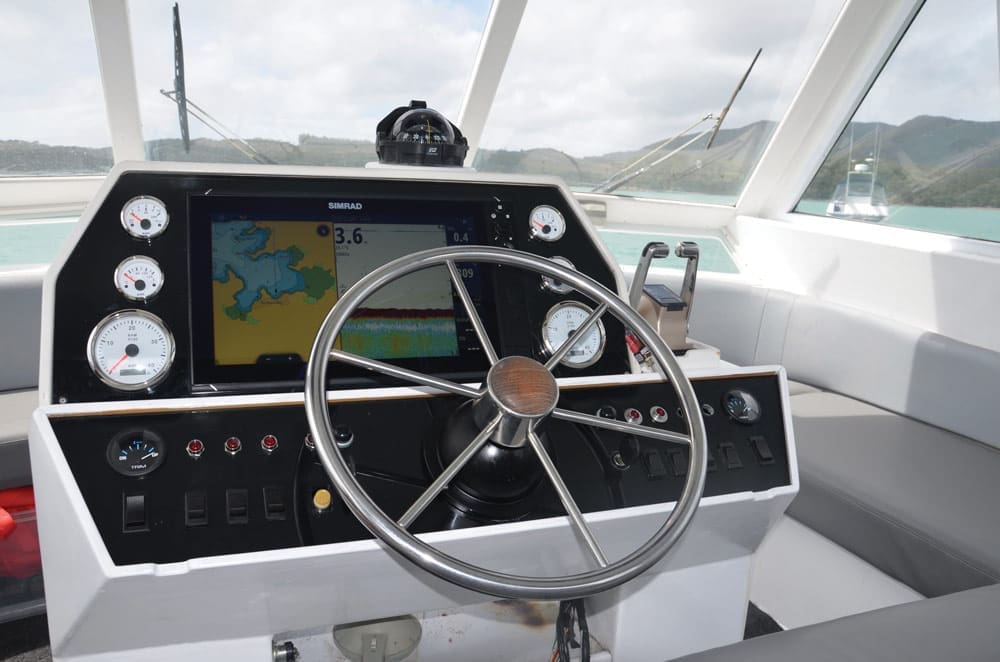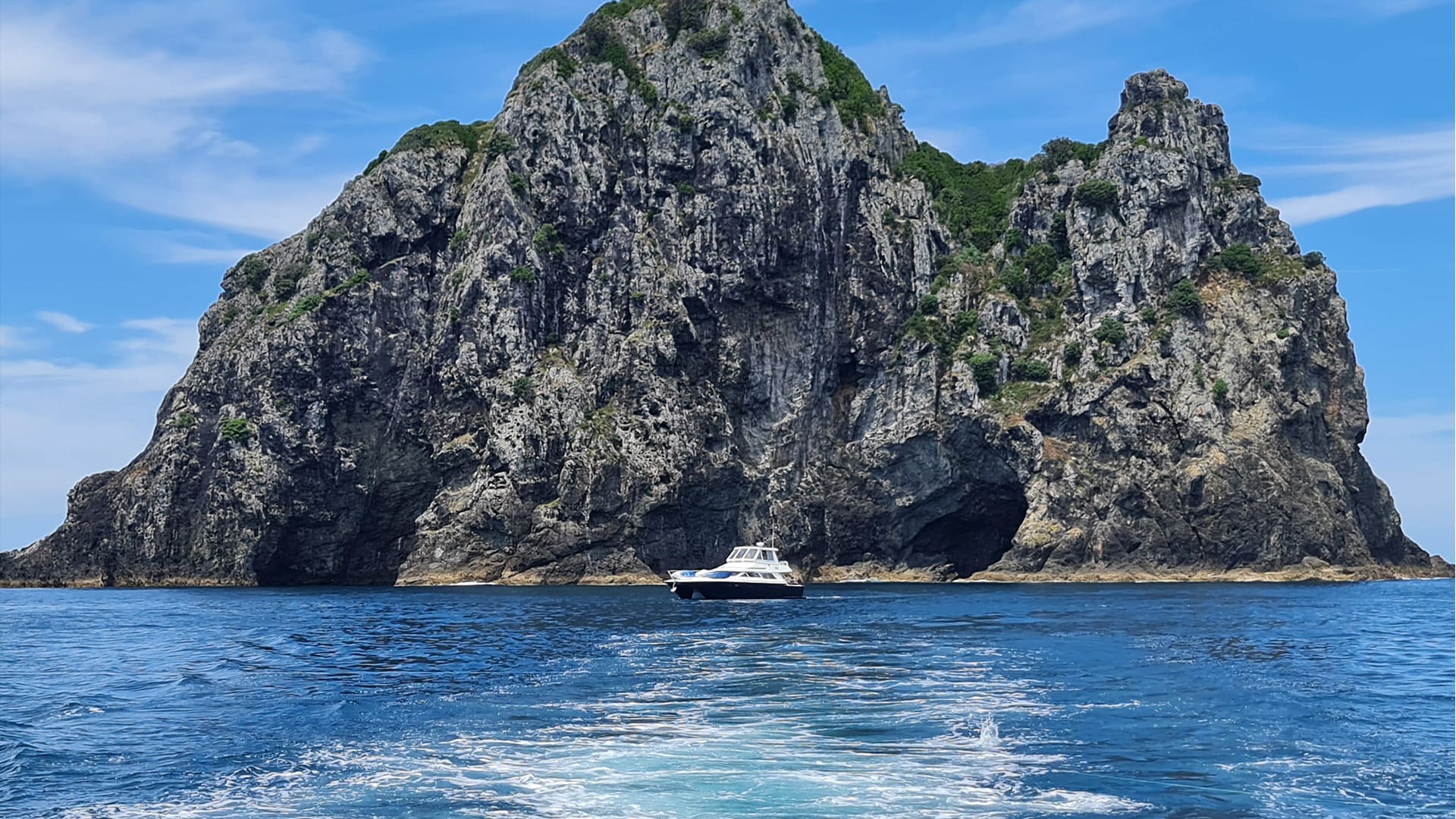Our Family Yacht: History In the Remaking
Starting life as a pilot boat for America One in the America’s Cup race in 2000, a 14m (50ft) launch, a catamaran or twin hull motor yacht had made its way into our family. After 20 years of many family trips though it was in much need of some love and attention, so we set out to give the old vessel a bit of a facelift, some up to date electronics and a new paint job. We gave the project a good three months with the plan to pull it out mid August and keep it on the hard while we did the work. In normal times that would have given us a huge window to get the work done but of course, these aren’t normal times.
We chose to pull the boat out at Marsden Cove up north. Such a great facility with all the amenities and easy access from Auckland. The rates there were nearly half that of Auckland too. The only trouble was for the entire three months we were stuck in Auckland in lockdown while the boat was on the hard in Northland. All wasn’t lost though as we were able to access all of the services and the guys that were doing the refit were able to travel as essential workers.

Parts of the refit had to be delayed but we managed to get the bulk of the work covered. The hull needed to be refinished. The paint that was on it was peeling and looking pretty shabby. We wanted to give the boat a whole new look as well. Doing a lot of online research, we came across the guys at Marine Protection Solutions (MPSNZ).
Initially, we started talking to them about a relatively new product in the market for under the boat, a German product, called FlowSilikon. Intrigued by the antifoul properties and the opportunity to avoid having to regularly paint antifoul onto the bottom each year as required by most harbours across the country. This product is a silicon adhesive that slides through that water adding extra speed and alleviating the need to paint – giving seven years or more of protection and very little need of attention. Unfortunately, this ended up being one of the casualties of Covid with the supply chain being affected and none available until later in 2022.

It was the team at MPSNZ however that introduced me to their 3M adhesive wrap. Once again a low maintenance product. Used extensively within the motor industry and for signage, the product is a vinyl that is resistant to the harsh climate that the sea puts up. With a huge range of colours and deep hues, it would deliver the look and feel we were looking for. Being a 3M product too we knew it would be of the highest quality and something they stand by with robust guarantees. The original hull colour was white but we wanted to make the boat really stand out so we went for navy blue with a gold stripe around the waterline.
Going with the darker colour did mean that we needed to have a good finish as any imperfections will stand out more and white is a lot more forgiving. What we didn’t foresee was the reason the paint was deteriorating in the first place. The undercoat was also faulty.

The sanding a fairing that we felt we could cover ourselves turned out to be a far bigger job than we’d anticipated. Whether we finished with paint or finished with a wrap we had no choice but to strip the entire undercoat back to the fibreglass underneath and pretty much start again.
Having spent two weeks solid, a team of four guys finally had it ready to wrap. We could have opted for paint but with paint, we would also need multiple coats. Based on price, resilience and finish the 3M we decided wrap was by far the best choice with a deep navy blue finish contrasting the white and gold the outcome was stunning.
The next step was to upgrade the electronics. Looking at the options available there are about five players in the market when it comes to fishfinders and chart plotters. What stood out for us with Simrad is that they have a local office here in NZ and even some of their research and development is based on Auckland North Shore. It meant that any issues or exchanges we needed were sorted out quickly and easily. We could have a conversation with Simrad here in NZ without having to go overseas.

The shopping list was extensive. We wanted to install autopilot, chartplotter, radar and fishfinder. Everything was provided by Simrad and all to the highest standard. We engaged a boat builder to rebuild the drive station to accommodate the 16 inch screen. The old Yanmar gauges were pretty dated and not overly appealing. Initially, we were looking to integrate the gauges into the screen but discovered that the engines weren’t compatible, given their age, so we had to then look at new gauges which also meant new senders.
Covid hadn’t given up on trying to disrupt the whole project though. Delivery issues, logistics and manufacturing slowdowns meant that some parts were taking weeks to deliver – an issue that was affecting the whole market at the time but something we just had to accept.
The final parts arrived but we were now weeks away from Christmas. The race was on to get everything done. We were finally able to escape Auckland on the 15th of December and had just one week to get it all finished.
Finally, the boat builders completed the console and the installer was able to put all of the gauges in place and install the Simrad system. The carpets went in, the new awnings went up and the final touches of paint went on and at last, we were ready to go just a few days before Christmas.
The sea trial went like a dream and we were able to set sail for the Bay of Islands on Christmas Eve. The new chartplotter/depth sounder went like a dream – so easy to use and has such amazing resolution.
Features of the 16-inch screen meant we were able to link the screen to our iPads (one in the transom and one in the master cabin). That way we can now monitor the fish when we are out the back or keep an eye on any movement if we are on the anchor from the master cabin at night. The split-screen means you can monitor the plotter, radar and depth all at once.
The radar can be transposed over the chart so you can see the exact location of any objects – great if you have limited visibility at night or in fog. The autopilot is controlled from the screen or we have a separate control on the arm of the drive seat. A separate screen downstairs allows us to keep an eye on the autopilot and change course if needed.
We finally hit the bay that afternoon and enjoyed a well earning break after such a whirlwind finish. The time in the bay with the boat all done up with new finish and new electronics was outstanding. Next step we want to sort out the deck and hopefully, we will get to proceed with the silicon wrap underneath but that’s another story.

